The AmirantesRemote and visited by just a handful of people each year, the Amirantes is a linear chain of islands and atolls. African Banks, the northernmost, lies 235 km from Mahé. Other islands are Rémire, D'Arros, St Joseph's Atoll, Desroches, Poivre Atoll, Etoile, Boudeuse, Marie-Louise, and Desnoeufs. These islands were once the food baskets of Seychelles, with large plantations growing coconuts and other crops for local use and export. As world markets changed, the islands' relatively small harvests became uneconomic to gather, and one by one they were abandoned. Today, most can only be visited by sea.
|
The Islands
African BanksAfrican Banks is an attractive, uninhabited island where seabirds breed in huge numbers. The sands are criss-crossed by turtle tracks.
|
RémireOnce a coconut plantation and a source of guano, Rémire was named Eagle Island, after a ship which visited in 1771.
|
D'Arros & St Joseph AtollPrivately owned, these islands are seabird sanctuaries, including Seychelles' second largest populations of Wedge-tailed Shearwater and Roseate Tern .
|
Sand CayCarrying on down the chain, we pass tiny, bare, Sand Cay, submerged by high spring tides but often covered in roosting terns of up to seven different species.
|
|
Etoile & BoudeuseEtoile is a pretty name for an island, but Boudeuse is more evocative, meaning "the sulker".
|
Marie Louise & DesnoeufsThese islands are closed to visitors. The former is a prison and the latter a Government-owned island and a main source of seabird eggs, still taken for local consumption.
|
History |
Marine Life
|
Flora & Fauna
|
|
In 1503, Vasco da Gama, returning from his second voyage to India, sighted islands that were subsequently - and with some consistency - noted on Portuguese charts as the “Islands seen the second time by admiral Dom Vasco”. From the Portuguese word almirante (admiral) we get the name of the Amirantes Group. Intriguingly one person aboard Da Gama’s ship reported sighting people ashore on one of these islands, gathered around a fire; probably shipwrecked sailors, desperately trying to attract their attention, however, the Portuguese sailed on.
|
Diving and snorkelling around the outer reefs of the Amirantes, corals, fish and other marine life flourishes. You can expect to see a hundred or more species of fish in a single dive, including angelfish, butterflyfish, lionfish, Napoleon wrasse and parrot fish of many species. In deeper waters, sailfish, manta rays and whale sharks are more common.
|
Seabirds are common in the Amirantes, in particular on the uninhabited islands. There are very few species of land bird, except for introduced species from the granitic islands. At the Island Conservation Centre on Desroches studies have shown cetaceans, including blue whales, can be sighted off the Amirantes Bank.
|

